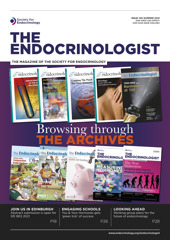FIRST PUBLISHED IN ISSUE 66 (2003)
Every spring, hundreds of endocrinologists gather together for 3 days to absorb new facts, gather ideas for research and socialise with old friends. Then they all return home and settle down to work for another year, until the following spring when they repeat the same thing all over again. Though certainly a well-loved ritual, it is difficult to believe that meetings of the BES only date back 20 years. How and why they came into being has already started to fade into the mists of time.
Endocrinology changed dramatically between 1960 and 1980, a period when my contemporaries and I were mostly training or had just become consultants. The clinical endocrinology of the 1950s was largely descriptive. The symptoms of many endocrine disorders had been recognised, but few hormone assays were available or accurate. Peptide hormones could not be measured at anything like physiological concentrations, and individual steroids could only be measured by isotope dilution after isolation by days of paper chromatography. We were consequently ignorant of most things that are now taken for granted.
After 1960, the introduction of radioimmunoassays, the rapid advances in cell biology and biochemistry and the development of computed tomography and magnetic resonance scanning made endocrinology one of the most rapidly advancing and fascinating fields of medicine and basic science. These advances attracted many highly intelligent graduates; existing endocrine units expanded rapidly and new units developed across the country.
The traditional means of exchanging information came under increasing strain. The twice-yearly meetings of the Society for Endocrinology were largely devoted to basic science, the Endocrine Section of the Royal Society of Medicine (RSM) met monthly and catered for clinical presentations, while smaller, specialist societies such as the Thyroid Club, the Bone and Tooth Society, the Ovarian Club and the Hormone Section of the Biochemical Society dealt with special interests. These were the main meetings for the presentation of endocrine data. Most took place in London, presenting difficulties for the increasing numbers who worked elsewhere. Anyone who wanted a broad overview of British endocrinology needed to subscribe to a bewildering variety of societies, some of which were not accessible to juniors.
For all these reasons, and because many of us had enjoyed the International Congresses of Endocrinology, the 2-yearly Acta Endocrinologica meetings in Europe and the Endocrine Society meetings in the USA, my contemporaries and I favoured a single, big annual meeting in the UK, to cover the whole field. But we had to convince those senior to us of the need for change.
'BES meetings have certainly served to meet the key objective of their original organisers – to promote the international reputation of British endocrinology!'
Our seniors were in all the positions of power on the important committees. They too were affected by the rapid changes in the field, but also had a medicopolitical agenda. British endocrinology had made great advances, but they felt that it hadn’t received the recognition that it deserved overseas. Those who were already convinced of the need for a new national annual forum also saw it as an opportunity to increase the worldwide influence of British endocrinology. From 1970 onwards, moves to strengthen international ties were made.
One of the foremost problems was British representation on the committee of the International Society of Endocrinology, which was responsible for the 4-yearly International Congresses. The number of representatives from each country depended upon the size of the national endocrine society. But which of the plethora of British societies should be approached for nominations and how many representatives should there be? To try and provide some unity, a Liaison Committee with representatives from the two main societies was established, and in 1975 the British Diabetic Association was also invited to join.
Moves were also being made to broaden and improve the standard of scientific presentations at the Society for Endocrinology’s spring meetings. In 1978, the then Chairman, Roger Short, suggested that it should become more like a symposium, with two or three major lectures, that some of the meetings should be held outside London, and that the Endocrine Society should be approached with a view to establishing transatlantic lectureships.
These ideas were favourably received and further developed informally, until, at a meeting of the Liaison Committee in October 1980, it was suggested that a loose federation of British endocrine societies should be formed, with a view to holding an annual general endocrine meeting. The proponents of this scheme seem to have included Lesley Rees, Vivian James, David London and John Phillips, as well as Roger Short from the Society for Endocrinology, and Michael Besser, Chris Edwards and David Heath from the RSM.
In May 1981, at a meeting with representatives from several of the specialist endocrine societies and the Irish Endocrine Society, it was agreed to form a new Liaison Committee, tasked with the organisation of an annual meeting of British Endocrine Societies (BES). Some of the societies feared loss of their individuality. On this basis, the British Diabetic Association decided to hold its own meeting, but on the same site and immediately following the BES, with a joint symposium linking the two meetings. Likewise, the Thyroid Club chose to hold its own meeting within the BES, though open to all, and including the annual Pitt-Rivers Lecture.
The British Endocrine Federation was recognised by the International Society for Endocrinology, and so achieved the other aim of allowing full representation on that body.
From these beginnings, the annual BES meetings have gone from strength to strength. The scientific standard has remained exceptionally high, other societies have joined in, and overseas representation has increased. Above all, the BES meetings have certainly served to meet the key objective of their original organisers – to promote the international reputation of British endocrinology!
COLIN BEARDWELL
I am very grateful to all who have helped compile this record in response to my queries: Lesley Rees, Clara Lowy, Howard Jacobs, Roger Short, Michael Besser, David London and Vivian James.





